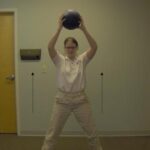Ataxia is the term given to any number of abnormal movements that take place while doing some voluntary movement. It sounds simple enough.
I guess that whenever medical terms or definitions are involved things can get a little (if not a lot) complicated for most of us so, I’ll try to put it in layman’s terms.
Folks suffering from ataxia have problems coordinating muscle movements. Often, these problems manifest themselves in the legs but also in the arms, eyes and in muscles used in speech.
Some of these involuntary movements result in you experiencing incoordination or interruption in your movements. Lots of MSers, like you and me, have experience this type of Ataxia when we under – or over – shoot something we intended or target with our hand, arm, leg or eye.
This missing of target is a type of Ataxia known as Dysmetria.
Since my diagnosis, I started to experience Dysmetria of the hand. This can make your writing and picking things up difficult or even impossible.
Your cerebellum is the part of your brain in charge of synchronizing all voluntary muscle movement throughout your body, cerebellar ataxia is the result of lesions on the cerebellum or in the nerves that connect into it. Cerebellar ataxia can result in:
• Uncoordinated walking – gait ataxia.
• Inability to maintain a steady posture – hypotonia.
• Shaking when attempting fine movements – intention tremor.
• An inability to coordinate the muscles involved in speech – dysarthia
• Jittery eye movements – nystagmus
If the damage is located in the spinal cord – in its posterior columns to be more exact – the type of Ataxia that occurs is known as sensory ataxia.
Whenever you experience not knowing exactly where your limbs (hands and feet) are, you are experiencing Sensory ataxia.
Another manifestation of this type of Ataxia happens when you experience an unstable stance.
Common problems seen by this type of Ataxia are:
• Loss of position sense
• Inability to detect vibrations
• Unstable stance also known as Romberg’s sign
In multiple sclerosis, the last type of Ataxia is known as vestibular ataxia which is caused by lesions to the brainstem and the vestibular nuclei.
Common problems seen by this type of Ataxia are:
• Loss of Balance
• Dizziness, nausea and vomiting (vertigo)
• Jittery eye movements – Nystagmus
I know now that I experienced this type of Ataxia when I had my first MS relapse. It came with a loss of balance, dizziness, vertigo and a little jittery of the eyes (nystagmus) besides the optic neuritis that never really went away.
Contrary to what most people think, Ataxia is not a direct result of muscle weakness (atrophy) but a dysfunction in the sensory nerve inputs or motor nerve outputs.
HOW COMON IS ATAXIA AMONG MSers?
It is estimated that between 80 and 85% of MSers will experience ataxia or tremors at some point during their disease.
Ataxia is quite a common symptom in Multiple Sclerosis but is also seen in other conditions such as:
1. Spinal cord compression
2. Diabetic polyneuropathy
3. Acute transverse myelitis
4. Vacuolar myelopathy
5. Tumor or cord compression and
6. Hereditary forms of ataxia
HOW IS ATAXIA TREATED IN MSers?
In order to help you manage these symptoms, several different treatments currently exist. They can be categorized by:
• Physiotherapy
• Neurosurgery
• Oral medications – Some of them containing marijuana or cannabis extract, isoniazid or baclofen.
The Cochrane Collaboration, currently published in the Cochrane Database of Systematic Reviews 2010 Issue 11, Published by John Wiley and Sons, Ltd. concludes that there is not enough evidence to suggest that any treatment (drugs, physiotherapy or neurosurgery) provides sustained improvement in ataxia or tremors.
The one thing everybody seems to agree on is that more research is required.
Last but not least, along with the multiple problems caused by ataxia, you may experience tremors.
Tremors are rhythmic shaking movements of different amplitudes.
Whenever I stand in the same place for too long, I experience tremors in my right knee. These tremors are nothing serious and once I start moving they just vanish. While researching the subject I found out that tremors in MSers are mostly affecting the head, neck, vocal cords, trunk or limbs.
TIPS & EXERCISES FOR ATAXIA
In ataxia the person presents.
- Incoordination
- Tremor
- Disturbances of posture
- Balance and
- Gait
Physiotherapy is directed at promoting postural stability, accuracy of limb movements, and functional balance and gait.
Postural stability can be improved by focusing on static control (holding) in a number of different weight bearing , antigravity postures (e.g. prone on elbow, sitting, quadruped, kneeling, plantigrade and standing).
Progression through a series of postures is used to gradually increase postural demand by varying the base of support and raising the centre of mass and increasing the number of body segments (degree of freedom) that must be controlled.
Specific exercise techniques designed to promote stability include:
- Joint approximation applied through proximal joints (through shoulders or hips) or head or spine
- Alternating isometrics (PNF)
- Rhythmic stabilization (PNF)
Patient with significant ataxia may not be able to hold steady and may benefit from the technique of slow reversal- hold (PNF), progressing through decrements of range. The desired end point is steady mid range holding.
Dynamic postural responses can be challenged by incorporating controlled mobility activities such as:
1. Weight shifting
2. Rocking
3. Moving in and out of postures or movement transitions
The patient should practice important functional movement transitions, such supine to sit, sit to stand and scooting.
Distal extremity movements can be superimposed on proximal stability to further challenge dynamic postural control. For example, resisted PNF Chop or lift patterns combined upper extremity movements with trunk movements (flexion rotation or extension with rotation).
An important goal of therapy is to promote safe and functional balance.
Static balance control can be improved by using force platform training. The person with ataxia learns to reduce the postural sway (frequency and amplitude) and control centre of alignment position. The added biofeedback from visual and or auditory feedback display can improve control in some patients.
Somatosensory, visual, and vestibular inputs can be varied, as appropriate, to assist in sensory compensation in sensory system less involved, for example:
- Standing with eyes open to eyes closed
- Standing on flat surface top a foam surface
Prolonged latencies (onset of responses) should be expected. Dynamic balance control can be initiated using self initiated movements (e.g. reaching, turning, bending). A movable surface can also be used. For example, sitting activities on Swiss ball are an excellent way to promote balance control.
Control of dysmetric limb movements can be promoted by PNF extremity patterns using light resistance to moderate force output and reciprocal actions of muscles for example: slow reversals, slow reversal- hold.
Frenkel’s Exercises can be used to remediate the problems of dysmetria.
The exercises are performed in supine, sitting and standing. Each activity should be performed slowly with the person using vision to guide correct the movement. The exercises require a high degree of mental concentration and effort.
For those patients with prerequisite abilities they may find helpful in regaining some control of ataxic movements through cognitive processes.
Ataxic movements have sometimes been helped by the application of light weights to provide additional proprioceptive loading and stabilize movements.
The use of Velcro weight cuffs (wrist or ankle) or a weight belt or weight jacket can reduce dysmetric movements and tremors of the limbs and trunk. The extra weights will also increase the energy expenditure, and must, therefore, be used cautiously in order not to bring about increased fatigue.
Weighted canes or walkers can be used to reduce ataxic upper limb movements during ambulation. For patient with significant tremor, this may mean the difference between assisted and independent ambulation. Elastic resistance bands can be used to provide resistance and reduce ataxic movements.
The pool is an important therapeutic medium to practice static and dynamic postural control in sitting and standing. Water provides graded resistance that slow down the person’s ataxic movement, while the buoyancy aids in upright balance. Swimming and shallow water calisthenics have shown to be effective in improving strength, decreasing muscular fatigability and increasing endurance. Furthermore, the use of moderate or cool water temperature may help moderate spasticity.
In general folks with ataxia do better in low stimulus environment that allows them to concentrate more fully on their movements. They benefit from augmented feedback (verbal cuing of knowledge of results, knowledge of performance, biofeedback) and repetition to improve motor learning.
About the author:
My name is Alejandro Bermúdez. I am 47 years old, married and the proud father of a beautiful 5 years old baby girl.
.
I lived in the United States for more than a decade and currently reside in Nicaragua with my Wife, Alina Alejandra and our little miracle from God.
Alejandra de María, that’s our baby girl’s name, was born December 7, 2005. Almost, 10 years after we got married, two operations that Alina had to bear, five inseminations and two in-vitro procedures.
For the last 14 years I have experienced the rollercoaster that is life with this chronic and unpredictable illness. The http://www.ms-multiple-sclerosis-symptoms.com website was launched November of 2009 to provide valuable and much needed information on Multiple Sclerosis from a patient’s perspective and point of view.
Unlike all the medical and pharmaceutical sites that discuss MS, all the information (well research facts) on my e-books and on my website go with a touch of a personal perspective and my experiences with many of the afflictions or ms symptoms experienced by all of us with Multiple Sclerosis (MS).
You are welcome to send any comments, questions or suggestions to my me at [email protected]




